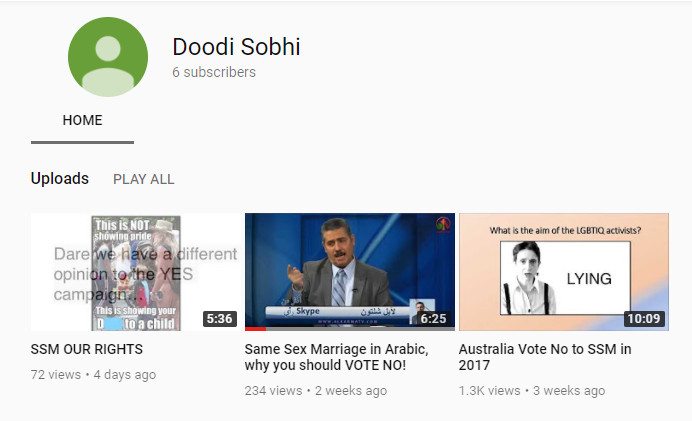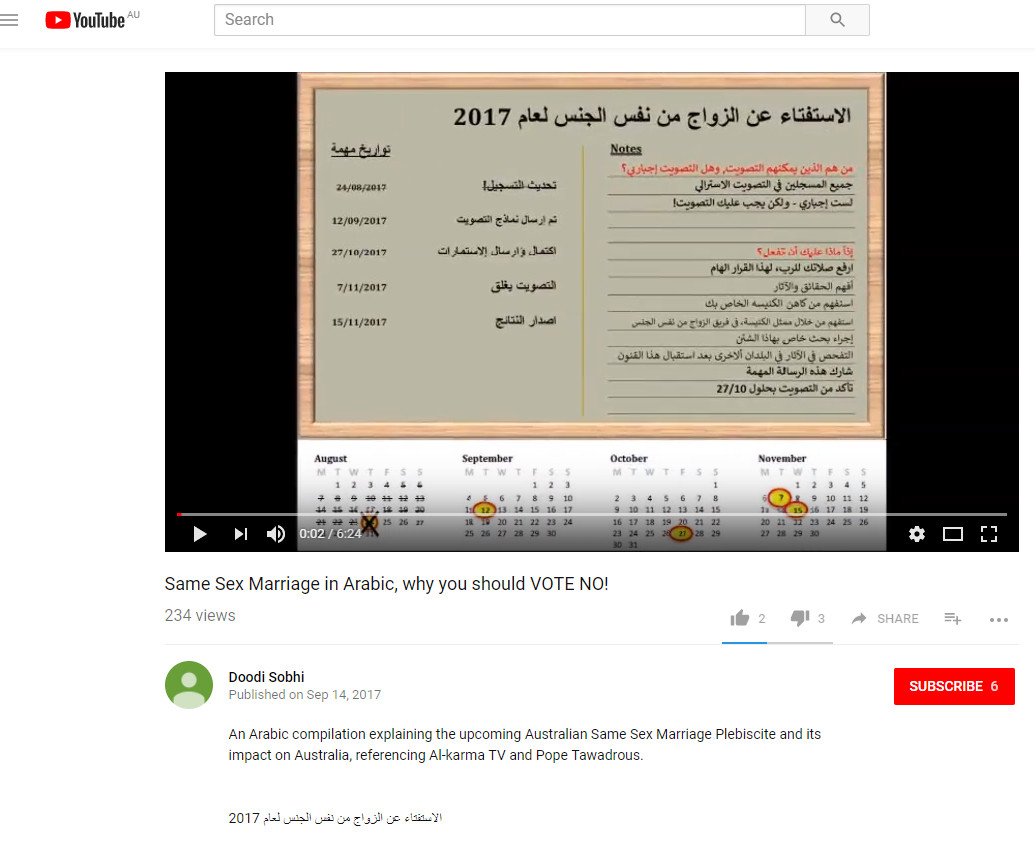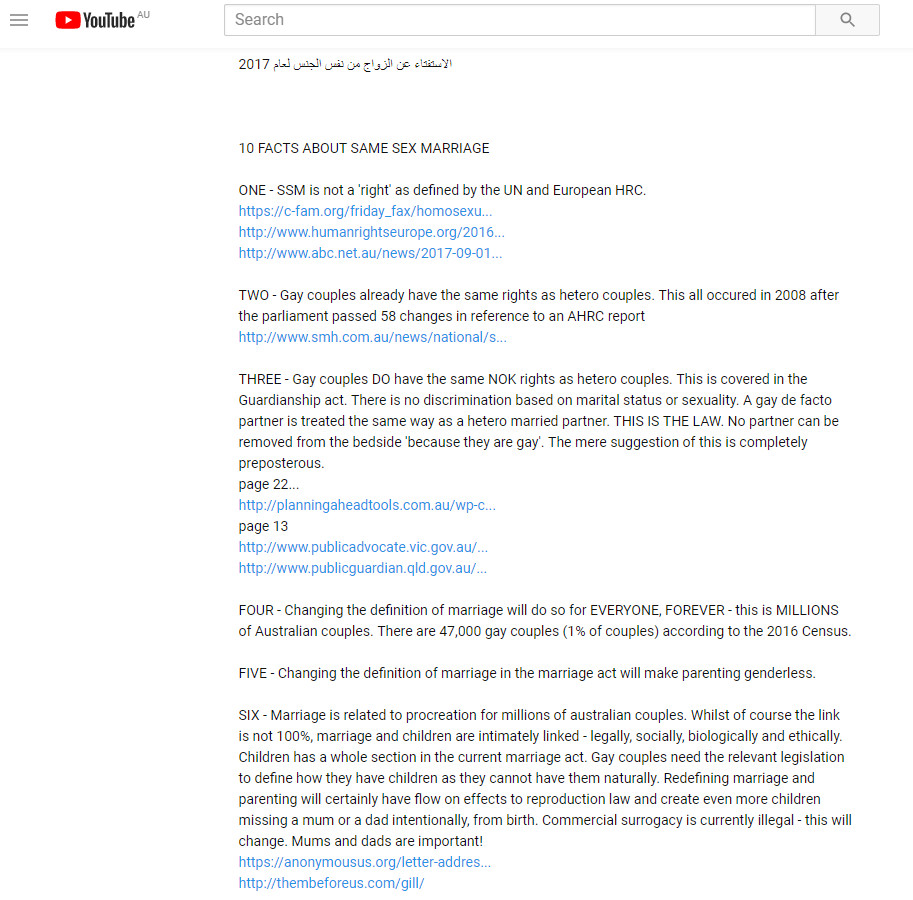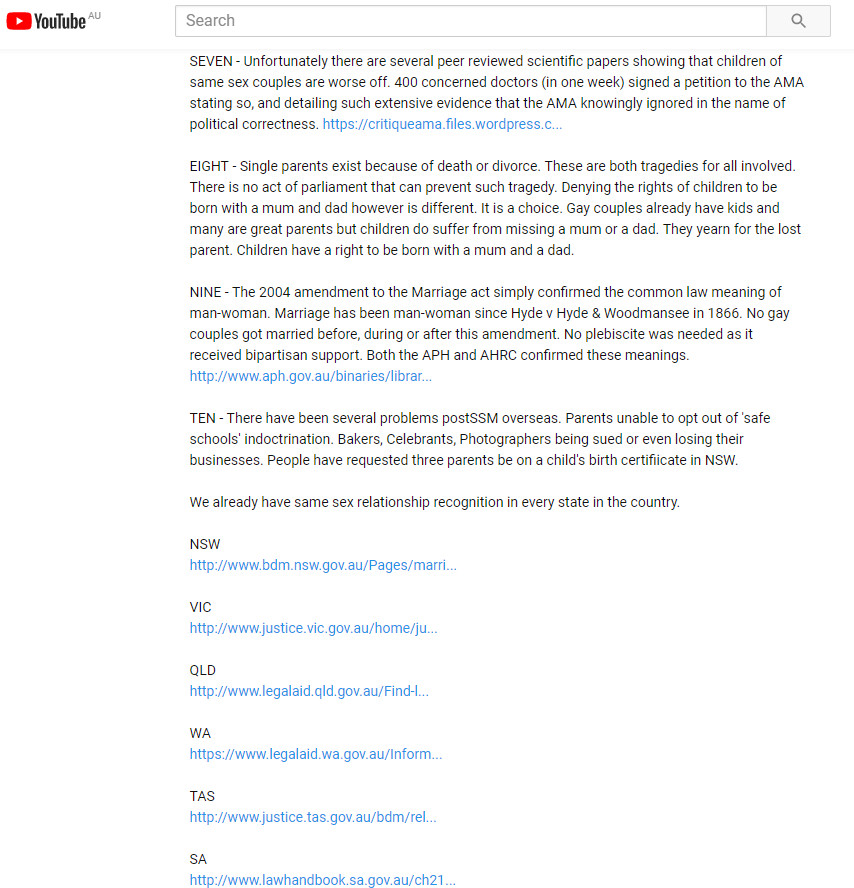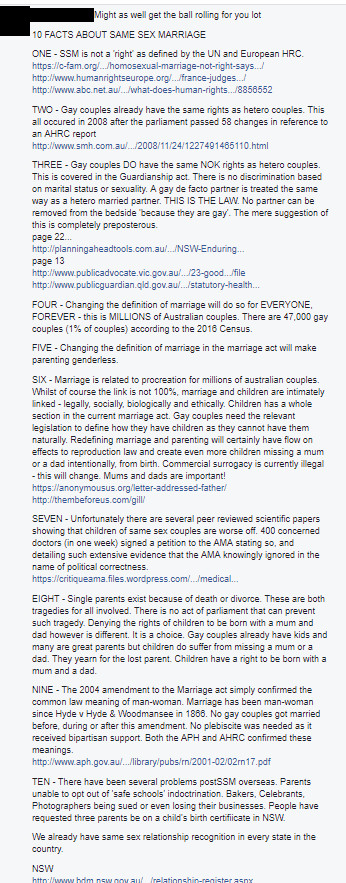In a comment on our Facebook page headed “10 FACTS ABOUT SAME SEX MARRIAGE” argues against a “yes” vote in the Postal Survey on Same-Sex Marriage. The post is long, detailed, and with quite a few links to external sources. This briefing looks first at where the content came from, then it addresses the arguments raised in these “10 facts” before ending with a conclusion and some recommendations for those engaging in online discussion. This article is part of our #DebateWithoutHate campaign supporting participation in public discussion and opposing bullying and bigotry during the Same-Sex Marriage Postal Survey. If you encounter bullying or bigotry (against either side or any individual or group) in discussion about the postal survey please report it to us so it can be added to our archive.
Comments on this briefing can be left at this Facebook thread. You can also help spread the word by sharing this article:
Where it came from
The content posted to our page is not original. It forms the description to the YouTube video “Same Sex Marriage in Arabic, why you should VOTE NO!” (ID: Huv7JHOFuME) which was uploaded on Sep 14, 2017. The video is not popular and currently has 234 views. The channel it is from only has 3 videos uploaded and no other activity. The earliest video is from 3 weeks ago. All the videos are against same-sex marriage. This is a dedicated account campaigning on the topic. It’s possible the person who posted the text to our page is the owner of the YouTube account and wanted to find a new channel to get their message out.
Here’s the post on our Facebook page, note how even the formatting is identical:
The post was like 11 times on our Facebook page. Looking at those who liked it, 4 of them appear to be fake profiles with under 30 friends. One looks like a brand new account and has an “I’m voting yes” profile which doesn’t fit with liking this post, unless the account was created for trolling. Others are real people, some involved in re-sharing content from groups campaigning for the “no” side e.g. the Australian Christian Lobby, others aren’t.
Responding to the 10 points
In our responses below the points from the original post. The links to referenced content (as seen above) have been omitted.
ONE – SSM is not a ‘right’ as defined by the UN and European HRC.
Not mentioned is the situation in the United States where same-sex marriage was found to be a ‘right’ by the Supreme Court in 2015 (Obergefell v. Hodges, 576). U.S. Justice Kennedy explained, “No union is more profound than marriage, for it embodies the highest ideals of love, fidelity, devotion, sacrifice and family. In forming a marital union, two people become something greater than once they were… [marriage is a] keystone of our social order, [the plaintiffs seek] equal dignity in the eyes of the law.” The ruling holds that: “The Fourteenth Amendment requires a State to license a marriage between two people of the same sex and to recognize a marriage between two people of the same sex when their marriage was lawfully licensed and performed out-of-State.” The 14th Amendment is the one that states “No State shall make or enforce any law which shall abridge the privileges or immunities of citizens of the United States; nor shall any State deprive any person of life, liberty, or property, without due process of law; nor deny to any person within its jurisdiction the equal protection of the laws.” (See more at the New York Times)
In terms of the UN, the International Covenant on Civil and Political Rights states in Article 23(2) “The right of men and women of marriageable age to marry and to found a family shall be recognized.” The case of Joslin v New Zealand before the UN in 2002 established that these words could not be interpreted as implying a positive obligation on states requiring them to allow same sex marriage. As the Human Rights Law Resource Centre explained back in 2009, the case, “does not prevent states parties from recognizing same-sex marriage. The majority decision in the case merely stands for the proposition that the ICCPR does not impose a positive obligation on states to do so.” The Human Rights Law Resource Centre went on to explain that “the narrow definition of marriage in Joslin, adopted almost a decade ago, is out of step with current human rights principles and with the values of contemporary Australians”. (See more from the Human Rights Law Resource Centre). Given the number of countries which have enacted marriage equality laws since 2002, public attitudes on the matter and the legal opinion of the US Supreme Court, the argument that Joslin was interpreted too narrowly and is out of step is even strong today than it was in 2009. Society has moved on, and so does our understanding on equality and human rights.
In terms of the European Court, as the ABC article cited itself mentions that the court has said, “marriage has deep-rooted social and cultural connotations which may differ largely from one society to another”. The Court has therefore has not imposed a ruling that requires states to have same-sex marriage. The choice is left to each state. The court has, however, recognised the right to equality and while the word “marriage” does not have to be used, there is a need for same-sex couples to be able to live “in a relevantly similar situation to a different-sex couple as regards their need for legal recognition and protection of their relationship”. (See more in the ABC article cited on this point). This suggests the right to what is popularly understood as marriage does exist, just not a right to the word itself.
Australia must decide for itself whether marriage equality is now a right in this country.
TWO – Gay couples already have the same rights as hetero couples. This all occurred in 2008 after the parliament passed 58 changes in reference to an AHRC report
This is not correct. The article cited itself notes in the opening paragraph that the 2008 amendments were about “honouring an election commitment to remove discrimination against same-sex couples from a wide range of federal laws”. Not all of our rights come from federal law. State law also plays a large role. If the definition of marriage was changed under federal law it would change the meaning of the state laws each time a reference was made to being married. To give one example, only married couples can adopt a child in the Northern Territory. Changing the definition would allow same sex couples to adopt in the Northern Territory, just as they can in the rest of the country.
Additionally, even with federal law, where marriage couples get their rights automatically on showing their marriage certificate or ticking a box stating they are married, de facto couples (whether different-sex or same-sex couples) have to prove their status each time before accessing their rights. This is an additional cost and stress that often occurs during times which are already high stress, for example if the partner is hospital and critical medical decisions need to be made. (See more in this article at the ABC).
In short, while much was fixed, there remains a gap which could be closed if Australian law allowed same-sex marriage.
THREE – Gay couples DO have the same NOK rights as hetero couples. This is covered in the Guardianship act. There is no discrimination based on marital status or sexuality. A gay de facto partner is treated the same way as a hetero married partner. THIS IS THE LAW. No partner can be removed from the bedside ‘because they are gay’. The mere suggestion of this is completely preposterous.
NOK is short for “next of kin”. Again, this is not entirely correct. “Gay couples” do not have the same rights, it is “de facto couples” that have the same rights. Yes, a same-sex couple may be a de facto couple… but the right only come into effect after this has been proven. This takes time, stress and cost. This is simply not required when someone is married. Again, see this ABC article.
FOUR – Changing the definition of marriage will do so for EVERYONE, FOREVER – this is MILLIONS of Australian couples. There are 47,000 gay couples (1% of couples) according to the 2016 Census.
If the law changes there would be no change for couples who are already married. The worst impact for straight couples wanting to get married in the future is that there may be just a little more demand for wedding venues. Everything about marriage in all other laws would continue as before and it already applies to couples who are married. This argument really makes no sense.
FIVE – Changing the definition of marriage in the marriage act will make parenting genderless.
No, it will allow children to have two moms or two dads. If you think about it, you already have two grandmothers and two grandfathers, it doesn’t make grand-parenting genderless.
SIX – Marriage is related to procreation for millions of Australian couples. Whilst of course the link is not 100%, marriage and children are intimately linked – legally, socially, biologically and ethically. Children has a whole section in the current marriage act. Gay couples need the relevant legislation to define how they have children as they cannot have them naturally. Redefining marriage and parenting will certainly have flow on effects to reproduction law and create even more children missing a mum or a dad intentionally, from birth. Commercial surrogacy is currently illegal – this will change. Mums and dads are important!
There is certainly an advantage to have a child brought up in a loving family. A same sex couple can, however, provide that. Many same-sex couples already have children thanks to medical help, adopt or prior relationships. Allowing those couples to be married rather than de facto couples will have no “flow on effects to reproduction law” as the law already allows same-sex couples to become parents.
SEVEN – Unfortunately there are several peer reviewed scientific papers showing that children of same sex couples are worse off. 400 concerned doctors (in one week) signed a petition to the AMA stating so, and detailing such extensive evidence that the AMA knowingly ignored in the name of political correctness.
As the President of the Australian Medical Association (AMA), Michael Gannon, has explained, “the issue before the Australian people, before the Australian parliament, is not about same-sex parenting. That’s not even the discussion that is being debated.” He’s right. Same sex couples can have children, for example with the support of IVF (see e.g. here). Since 2016, same-sex couples have been able to adopt in every Australian state (see more at this SBS article). There is still an issue with adoption in the Northern Territory, but calls have been made to change this (see more at this ABC article). With the except of the ability for same-sex couples to adoption in the Northern Territory, allowing same sex couples to marry will have absolutely no impact same-sex partners being parents.
There is a larger issue which was addressed by Jennifer Westacott, chief executive Business Council of Australia. She told ABC Radio National that claims children of same sex couples are worse off are “deeply offensive and wrong” (see more at The Guardian).
In a March 2017 review undertaken by Columbia Law School into research on same-sex parenting, 75 of the 79 studies examined “concluded that children of gay or lesbian parents fare no worse than other children”. Of the remaining 4 studies they explain “all four took their samples from children who endured family break-ups, a cohort known to face added risks, these studies have been criticized by many scholars as unreliable assessments of the wellbeing of LGB-headed households.” The author described one of the research methodology choices used across the four outlier studies as “so misleading as to be inaccurate”. (See more on the study.) In light of these facts, this argument is seeking to misinform the public. It’s true there are several (4 to be exact) scientific papers that conclude children in families with same-sex couples are worse off, but there are vastly more studies showing the this is not the case. Further, the studies being relied upon are known to be scientifically flawed and misleading.
The point about doctors is also misleading. The AMA, the peak body for doctors, formally declared support of marriage equality. In response 400 members, led by a former President of the AMA, signed a petition against same sex marriage. In response to that 2000 doctors signed a petition that not only supports the AMA’s stance, but condemns those doctors who oppose it (see the AMA letter). The letter with 2000 signatures calls marriage equality a “fundamental right” and warns that, “the emotional distress to the LGBQTI community of having a group of doctors publicly speak out against them being able to access fundamental human rights will show its effects in increased depression, anxiety, self‐harm, and suicidal behaviours”. That statement is presented not as an opinion, but as a fact with a footnoted to relevant peer reviewed research. Point Seven is running against the view of the medical profession as expressed by its peak body, and the majority of doctors. (See more at The Australian.)
EIGHT – Single parents exist because of death or divorce. These are both tragedies for all involved. There is no act of parliament that can prevent such tragedy. Denying the rights of children to be born with a mum and dad however is different. It is a choice. Gay couples already have kids and many are great parents but children do suffer from missing a mum or a dad. They yearn for the lost parent. Children have a right to be born with a mum and a dad.
This is a reiteration of points 5 and 7. It overlooks the fact that what matters is not having a “mum and a dad” but having a loving family. The gender of the parents is not relevant to that – as the review by the Columbia Law School established (see more on the study).
NINE – The 2004 amendment to the Marriage act simply confirmed the common law meaning of man-woman. Marriage has been man-woman since Hyde v Hyde & Woodmansee in 1866. No gay couples got married before, during or after this amendment. No plebiscite was needed as it received bipartisan support. Both the APH and AHRC confirmed these meanings.
This links to a briefing note from the Parliamentary Library (APH stands for Australian Parliament House) which does not support the argument being made. What it says is that “the High Court of Australia has… not given any detailed consideration on the meaning of the term ‘marriage’”. It lists what the Court has said in eight relevant cases, but many of them like McHugh J., in Re Wakim; Ex parte McNally simply suggest it would be up to the Parliament. McHugh J., explained “in 1901 ‘marriage’ was seen as meaning a voluntary union of life between one man and one woman to the exclusion of all others. If that level of abstraction were now accepted, it would deny the Parliament of the Commonwealth the power to legislate for same sex marriages, although arguably ‘marriage’ now means, or in the near future may mean, a voluntary union for life between two people to the exclusion of others”.
As to the AHRC, the Australian Human Rights Commission, their position is very simply. It’s on their website and says, “The Australian Human Rights Commission considers that the fundamental human rights principle of equality means that civil marriage should be available, without discrimination, to all couples, regardless of sex, sexual orientation or gender identity.” (See more at the Australian Human Rights Commission.) Again this is the exact opposite of what is claimed.
TEN – There have been several problems post SSM overseas. Parents unable to opt out of ‘safe schools’ indoctrination. Bakers, Celebrants, Photographers being sued or even losing their businesses. People have requested three parents be on a child’s birth certificate in NSW. We already have same sex relationship recognition in every state in the country.
The comments about the ‘Safe schools’ program is little more than dog whistling. It is not relevant to this discussion.
As to celebrants, photographers, bakers etc, yes, there have been issues with this mostly in the US after the Supreme Court rules it was a right and discriminating against a couple on the basis of their gender was therefore unlawful discrimination. It seems fairly likely the current parliament would only allow same-sex marriage if “safeguards” were put in place to prevent legal consequence for those that refuse to support it. As to boycotts by customers of businesses that choose to discriminate, people have the right to take their business to suppliers whose values they agree with. If there is legal protection, and a business wishes to rake advantage of that to discriminate, knowing there may be a public backlash against them, that is their choice. The public response is certainly one factor they should consider, but ultimately unless the law prohibits such discrimination, they can do as they please and take the consequences that result from that.
Conclusion
The 10 points include a number of inconsistencies, on the one hand claiming same-sex marriage is not needed as there are already equal rights, and on the other hand claiming allow it would significantly disrupt society. A number of sources are uses to support statements which the links simply don’t support – this relies on the fact many people will share content on social media without following the links. In some cases there are major omissions, for example when it comes to the scientific evidence and position of the AMA and doctors – in these cases minority positions are presented as established fact. Even experts writing opinion articles in the media are sometimes picking which facts to share.
The omission of the US legal position, that sees marriage equality as a right, is in our view a significant flaw in opinion piece at the ABC in point 1. This speaks to a wider flaw in today’s media where opinion is being published instead of investigative journalism. This leaves the public worse off as each opinion article seeks to advocate a particular view and may choose to ignore inconvenient facts. Investigative journalism by contrast would combine the key information from multiple sources and seek to close the gaps for the reader.
Recommendations for avoiding misleading information
- Ensure the fact you use in discussion are not misleading. Facts can be misleading when there is contradictory information which is “left out”, particularly when the contradictory information is in fact more robust and authoritative.
- Link to credible sources, not random blogs. As seen in the recent US election, there are efforts to promote fake news to shape public opinion. If you don’t know the authenticity of a source, find out, or don’t use it.
- Read any references, judge for yourself if they support the claims being made. Just because a link is given to support a statement, fact or argument, does not mean the source actually agrees. The only way to find out is to check the sources.
- Don’t share content until you have checked it – even when it supports your view!
- There are trolls and fake accounts out there. Make your own decisions, don’t like content just because a few other people have liked it… particularly when the numbers are low, the likes may be orchestrated.
The value social media can contribution to democracy is strongly linked to whether it helps inform people or whether it becomes a tool of misinformation and manipulation. We can all play a part in ensuring misinformation is called out, mistakes are corrected, out-of-date information is updated and opinions are separated from facts. If we can work together to make that happen, regardless of our views on any issue or support for any candidate or party, we can restore a little more faith in our democratic processes and our society as a whole.
Comments on this article can be left at this Facebook thread. You can also help spread the word by sharing this article if you didn’t do so above:
This campaign is supported by tax deductible public donations to the Online Hate Prevention Institute. If you can help, please donate here. Offers of corporate sponsorship for this campaign are also welcome as is media interest – please contact us.

